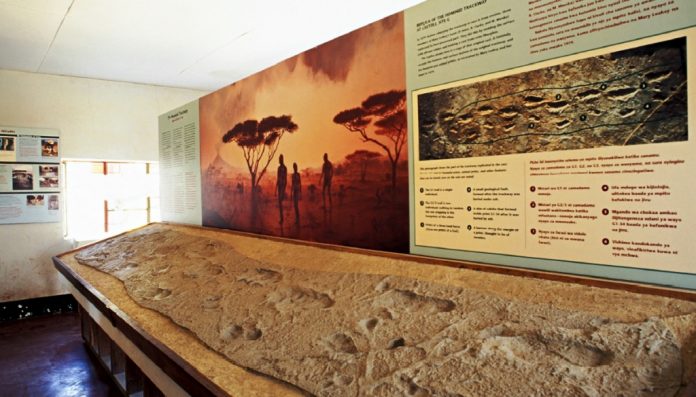The Laetoli footprint trail puzzled the scientific world when it was discovered. In the hot and shrubby Olduvai Gorge in northern Tanzania, water and geologic activity wore away sediment built up over millions of years to reveal stunning clues about the origins of humanity.
In 1978, at the archaeological site of Laetoli, archaeologists found stone tools, bone fragments, and the fossilized footprints of Australopithecus afarensis, our earliest known upright-walking ancestors. About 70 indentations forming a trail 88 feet (27 m) long are a remarkable record of a walk these early humans took some 3.6 million years ago.
Laetoli Footprint Trail is about 3.6 million-year-old footprints. Paleoanthropologist Mary Leakey and her crew were finding the tiny forked toes of birds and the hops of small mammals when they exposed the hominid tracks. Team member Paul Abell stumbled across them completely by accident; his find was as fortuitous as the exclusive conditions that sealed the prints in place for millions of years.
Rains following a volcanic eruption formed a thick, ashy paste that early humans walked over. Later, one more eruption covered their prints with extra sediment, preserving them for eons until erosion finally uncovered them. Since their finding, the Laetoli footprints have been scrutinized and analyzed for precious details about A. afarensis, the same species as the famed skeleton “Lucy” and the only known “hominin” in the region at that time. And what’s in a footprint?
As it turns out, a lot. The gait of the hominids was shorter than a modern human’s, suggesting that while A. afarensis had a similar stride (rocking from heel to toe), it also had shorter legs and was slower moving. The presence of a forward-facing big toe in the print indicated these walkers may have spent more time on the ground than in trees, since a divergent toe would indicate a creature better suited to climbing and grabbing branches.
Several scientists believe that a small social group or family may have made the tracks. A larger male walking with a smaller female, whose prints are more deeply indented on one side, possibly from the weight of carrying a child on her hip. Some believe that four distinct people created the prints at separate times.
Though visitors to Olduvai Gorge today won’t see the original prints—they’ve been cautiously cataloged and reburied for posterity—it is likely to take guided tours of area archaeological sites, touch a cast of them, and experience the electric sensation of walking across the same terrain as some of our earliest human ancestors.
“The simple evidence of the footprints, so very much like our own, indicates to me that the Laetoli hominid stands in the direct line of man’s ancestry,” wrote Mary Leakey in 1979 on her team’s astonishing discovery. Leakey first visited the Laetoli beds in 1935 with her husband, Louis, but found only fragmented fossils. In the 1970s, National Geographic support enabled her to go back and probe deeper, and her team uncovered the remarkable 3.6 million-year-old footprints that proved hominids had walked erect a half million years earlier than previously believed. By then, the Leakeys had spent decades in East Africa searching for evidence of the earliest man. In this photo from a 1965 National Geographic article, Mary searches for fossils in Olduvai Gorge. Her team in Africa was composed of more than archaeologists. “Dalmatians,” the article notes, “warn of leopards, lions, and other dangers.” Look closely, and you’ll see Mary also has a pet Sykes’ monkey perched on her shoulder.”.

Where to Stay: The site and the Olduvai Gorge Museum, run by caretakers from the local Maasai tribe, are often combined with safaris to the Ngorongoro Conservation Area and Serengeti National Park.
How to get there: Kilimanjaro International Airport in Arusha, about 264 km east of Olduvai, is the closest international hub (though most flights route through Dar-e-Salaam or Nairobi before heading on to smaller Arusha). A lot of safaris include airport transfers. For a devoted trip to Olduvai, you’ll have to need a car, and for anything beyond the museum, it’s better to hire a guide. National Geographic also offers trips to Tanzania.
